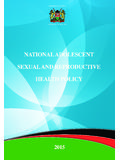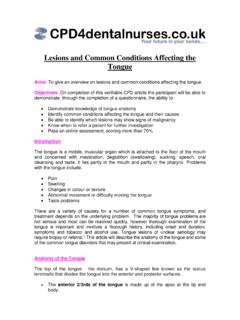Transcription of Adolescent Immunization Initiative Participants …
1 rationale FOR AN Immunization PL ATFORM AT 16 YEARS OF AGEIn the summer of 2016, a multidisciplinary group of 17 experts in Adolescent health and immuni-zation gathered in Baltimore for a 1-day meeting sponsored by Sanofi Pasteur. The group, called the Adolescent Immunization Initiative (AII), was created to focus on Immunization of older ado-lescents, defined here as persons 16 through 18 years of age (consistent with historical child and Adolescent Immunization schedules from the Advisory Committee on Immunization Practices [ACIP]).With Immunization rates for 16- to 18-year-olds well below national goals, AII s mission is to increase those rates by collaborating with stakeholders to establish an Immunization platform at 16 years of age.
2 Older adolescents have a lower rate of preventive visits than younger adolescents who have an estab-lished Immunization platform at 11-12 years of age and typically come to the office for reasons other than well care, such as sports physicals and completion of college forms. A platform for 16-year-olds could reduce vulnerability to vaccine-preventable diseases in this population and drive overall improve-ments in preventive care for adolescents, the benefits of which could reach into adulthood. A second dose of quadrivalent meningococcal conjugate vaccine (MenACWY) at 16 years of age has been recom-mended by the ACIP, American Academy of Pediatrics (AAP), and American Academy of Family Physicians (AAFP) since the beginning of this decade.
3 Unfortunately, a signif-icant gap exists between this recommendation and actual practice. Other vaccines that should be provided or at least reviewed at age 16 in accordance with the ACIP immuniza-tion schedule are also overlooked. 1 Oliver Brooks, MD, FAAPC hief, Pediatric and Adolescent MedicineMedical DirectorWatts Healthcare CorporationLos Angeles, CaliforniaJoanna Colbourne, BADirector, Communications & Public OutreachNational Foundation for Infectious DiseasesBethesda, MarylandAmanda Dempsey, MD, PhD, MPHA ssociate Professor of PediatricsUniversity of ColoradoDenver, ColoradoClaire Hannan, MPHaExecutive DirectorAssociation of Immunization ManagersRockville, MarylandDavid Kaplan, MD, MPHaProfessor of PediatricsHead of Adolescent MedicineUniversity of ColoradoDenver, ColoradoDaryl Lynch, MDaDirector, Division of Adolescent MedicineChildren s Mercy HospitalKansas City, MissouriGary S.
4 Marshall, MDaChief, Division of Pediatric Infectious DiseasesUniversity of Louisville School of MedicineLouisville, Kentucky(continued) Adolescent ImmunizationInitiative Participants Litjen (LJ) Tan, MS, PhDa Co-moderatorChief Strategy Officer Immunization Action Coalition Saint Paul, MinnesotaDavid P. Greenberg, MD Co-moderatorAssociate Vice President & Regional Medical Head North AmericaSanofi PasteurSwiftwater, PennsylvaniaThese issues resulted in a recent format change to the ACIP schedule to highlight a 16-year-old visit as a chance to review and provide immunizations. However, the change will not achieve its intended effect unless steps are taken to convert that visit into an actual Immunization platform with its own emphasis akin to the 11- to 12-year-old Immunization /preventive services visit, which has contributed to high Immunization rates for teta-nus, diphtheria, and acellular pertussis (Tdap) vaccine and the first dose of MenACWY.
5 That same emphasis at 16 years of age would help ensure that the second dose of MenACWY, as well as other vaccines, are assessed and administered as appropriate, and that additional preventive health strategies are delivered. The concept of an Immunization platform at age 16 years has been gaining favor among stakeholders in the health care community. The National Foundation for Infectious Diseases (NFID), for example, issued a call to action to health care pro-fessionals (HCPs) in March 2016, challenging them to improve Adolescent vaccination rates and recommending, among other measures, establishment of a vaccination platform at age 16 The Society for Adolescent Health and Medicine (SAHM) will be issuing a position statement in the spring of 2017 supporting an Immunization platform for With the approved format change to the Immunization schedule s table a distinct column for age 16 years (separate from ages 17 and 18 years)
6 With a shaded column heading the challenge now is to raise awareness about the signifi-cance of the change. Making the new column a true platform Donna Mazyck, MS, RN, CAEE xecutive DirectorNational Association of School NursesSilver Spring, MarylandAmy Middleman, MD, MPHa,b Chief, Section of Adolescent MedicineUniversity of Oklahoma Health Sciences CenterOklahoma City, OklahomaDonald Middleton, MDaVice President of Family Practice EducationUPMC St. MargaretPittsburgh, PennsylvaniaCarole Moloney, RN, MSN, CPNPP ediatric Nurse PractitionerBoston Medical CenterBoston, MassachusettsAudrey Stevenson, PhD, MPH, MSN, FNP-BCDivision Director of Family Health ServicesSalt Lake County Health DepartmentSalt Lake City, UtahTina Tan, MD, FAAP, FIDSA, FPIDSP rofessor of PediatricsNorthwestern UniversityFeinberg School of MedicineChicago, IllinoisJames Turner, MDFormer Executive DirectorDepartment of Student HealthUniversity of VirginiaCharlottesville, VirginiaDeborah Wexler, MDExecutive DirectorImmunization Action CoalitionSaint Paul, MinnesotaGregory Zimet.
7 PhDProfessor of Pediatrics and Clinical PsychologyIndiana University School of MedicineIndianapolis, Indianaa Steering committee member. b Received no reimbursements or remuneration of any kind from Sanofi vaccination coverage (%)VaccineTdap 1 doseaSecond dose rate based on 17-year-olds; b2015-2016 influenza 1 doseMenACWY 2 dosesaInfluenzabHPV 1 dose,femalesHPV 3 doses,femalesHPV 1 dose,malesHPV 3 doses,males607080901002015 Immunization Rates in Adolescents 13-17 Years of AgeFigure 1: Substantial gaps exist in Adolescent vaccination ,4 Healthy People 2020 sets a target of 80% coverage among adolescents for 1 dose of Tdap, 1 dose of MenACWY, and 3 doses of human papillomavirus (HPV), and 70% coverage for 1 dose of influenza vaccine.
8 No objective has been established for the second dose of ImmunizationInitiative Participants (continued)means engendering an expectation among parents, patients, and HCPs that 16 years is an age when ado-lescents receive certain vaccines and other preventive health care Immunization platform at 16 years of age has the poten-tial to improve the Adolescent health landscape by: Creating the expectation that adolescents are routinely immunized at this age, consistent with existing recommendations from the ACIP, AAP, and AAFP Ensuring that HCPs review MenACWY, meningococcal B (MenB), and (during flu vaccination season) influ-enza Immunization with 16-year-olds, and immunize accordingly, thus increasing unacceptably low vaccina-tion rates and helping protect older adolescents as they enter a key risk period for meningococcal disease Providing a chance to catch up on missed immunizations as appropriate for routinely recommended vaccines and to assess for vaccinations based on high-risk conditions Increasing preventive care visits Improving comprehensive care, including screening and reduction of risk behaviors Allowing for Immunization before the Adolescent becomes ineligible for coverage under the Vaccines for Children (VFC)
9 Program Empowering adolescents to embrace a greater role in their own lifelong wellness, including adherence to vac-cination recommendationsImpetus for Change Adolescent Immunization rates for Tdap vaccine and the first dose of MenACWY surpass Healthy People 2020 goals. However, rates for the second dose of MenACWY, human papillomavirus (HPV) vaccine series (first dose and the full series), and seasonal influenza vaccine lag well behind (Figure 1).3,4 The difference in Immunization rates between the first and second doses of MenACWY is stark. The rate for the first dose, recommended at 11-12 years of age since 2005, exceeded 50% by the end of 2009 and reached 81% in 2015.
10 In contrast, the rate for completing the second dose among 17-year-olds was only 33% in 2015, despite this dose being recommended at 16 years of age since By those estimates, 67% of eligible adolescents are not fully immunized during a period of life that places them at increased risk for meningococcal disease. Approximately 20% of the nearly 2000 deaths from the disease that occurred during 1999-2014 were in the 15- to 24-year-old age Case fatality rates are 10% to 15%, and up to 19% of survivors suffer long-term sequelae (eg, limb am-putation, hearing loss, cognitive deficits).6 For influenza, some 25% of pediatric deaths in the 2014-2015 and 2015-2016 flu seasons were among adolescents 12-17 years of In both seasons, the influenza vaccine Immunization rate for 13- to 17-year-olds was just 47%.



